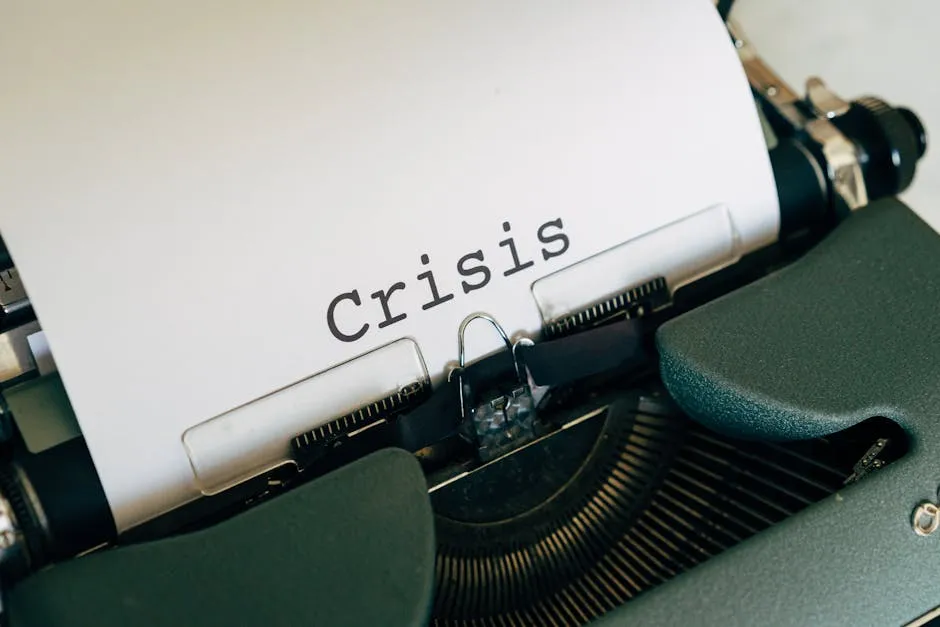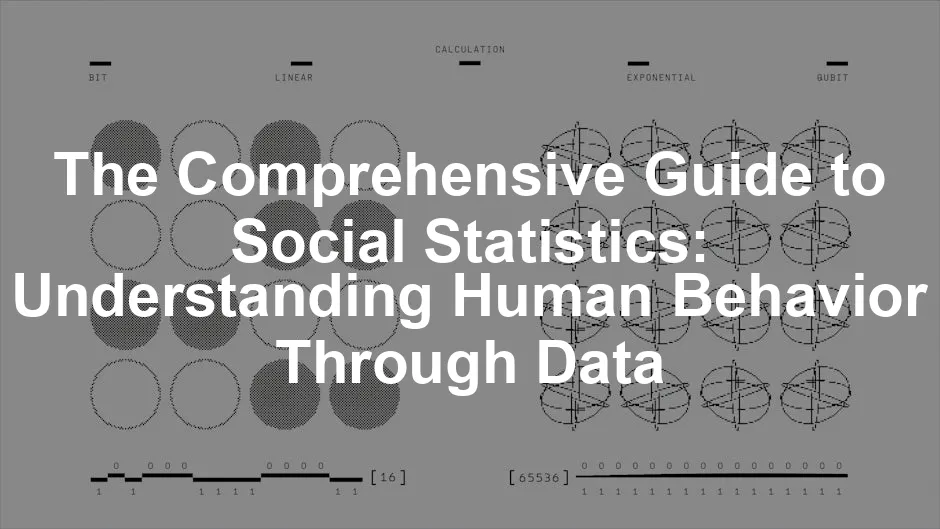Introduction
Social statistics is more than just numbers; it’s the key to unlocking the mysteries of human behavior. Think of it as the detective work of social scientists, where data becomes the magnifying glass revealing insights about our society. In a world where understanding human interactions and societal trends is crucial, social statistics plays an indispensable role. It offers a quantitative lens to examine how people interact within various contexts, be it in families, communities, or across nations.
The aim of this article is to provide a thorough overview of social statistics, covering its applications, methodologies, and the significance of data in social research. By unpacking this topic, we’ll shed light on how data collection techniques, statistical analyses, and interpretation help us understand societal trends. Whether you’re a budding statistician, a curious reader, or a policy-maker, this guide serves as your roadmap through the fascinating world of social statistics.
Social statistics is not just for academics; it impacts a variety of fields. In sociology, it helps us understand social structures and relationships. In psychology, it assesses behaviors and mental health trends. Economists utilize it to gauge market dynamics and public policy experts rely on it to evaluate the effectiveness of governmental programs. Essentially, social statistics acts as the backbone of informed decision-making in various sectors, influencing everything from healthcare to education policies.
To deepen your understanding of the principles behind social statistics, consider picking up “Statistics for People Who (Think They) Hate Statistics” by Neil J. Salkind. This book breaks down complex concepts into digestible pieces, making it perfect for those who find statistics daunting. You’ll be laughing while learning—what more could you want?

Understanding Social Statistics
Definition of Social Statistics
Social statistics involve the systematic use of statistical measurement systems to examine human behavior in social contexts. It focuses on collecting, analyzing, and interpreting data related to individuals and groups. Key components include surveys, observational studies, and various data collection methods that capture the essence of social phenomena. By employing rigorous statistical analysis, researchers can draw meaningful conclusions about societal patterns and behaviors.
The role of social statistics extends beyond mere data collection. It encompasses a range of methodologies, including descriptive statistics, inferential statistics, and advanced analytical techniques. These methods allow researchers to quantify social phenomena, test hypotheses, and establish relationships among variables, all of which are essential for understanding complex social dynamics.
History of Social Statistics
The history of social statistics is rich and fascinating, marked by contributions from several influential figures. Adolph Quetelet, often considered the father of social statistics, introduced the concept of “social physics” in the 19th century. His work laid the foundation for statistical methodologies that evaluated population data, such as average heights and ages at marriage. Quetelet’s pioneering efforts demonstrated how statistical analysis could illuminate social patterns, setting the stage for future developments in the field.
Another key figure is Karl Pearson, a statistician who advanced the science of statistics through his work on correlation and regression. His contributions during the late 19th and early 20th centuries helped formalize statistical methods that are still in use today. Pearson’s work made it possible to analyze complex relationships between variables, providing a framework that researchers continue to rely upon.
Over the years, social statistics has evolved significantly. From simple descriptive analyses to complex multivariate techniques, the field has adapted to the increasing complexity of social data. This evolution reflects the growing recognition of the importance of rigorous statistical methods in understanding human behavior and guiding policy decisions.
In summary, social statistics is a vital tool for researchers seeking to understand the intricacies of human behavior and societal trends. With its historical roots and ongoing developments, it continues to be an essential component of social science research. As we explore the applications and methodologies of social statistics, we will uncover its profound impact on our understanding of society. social statistics for a diverse society

Social statistics is essential for understanding societal trends and behaviors, especially in diverse contexts. social statistics for a diverse society
Importance of Social Statistics
Applications in Various Fields
Social statistics plays a vital role across multiple disciplines, from sociology to public policy. Within sociology, it reveals patterns in social behavior and structures. Think about studies that analyze the impact of social networks on individual well-being. They often rely on numerical data to support their conclusions, allowing sociologists to substantiate their theories with facts.
In psychology, social statistics help assess mental health trends. For example, a survey might reveal that 30% of college students experience anxiety. Such findings guide psychologists in developing targeted interventions. The National Institute of Mental Health regularly publishes reports that utilize social statistics to highlight these trends. If you’re interested in understanding mental health data better, check out “Introduction to the Practice of Statistics” by David S. Moore. This book is a fantastic resource for those looking to grasp the basics of statistical methodologies.
Economics, too, thrives on social statistics. Economists use data to understand market dynamics. The Consumer Price Index (CPI) is a classic example. It tracks changes in price levels, helping economists analyze inflation. Understanding these changes is crucial for crafting effective economic policies.
Public policy relies heavily on social statistics to shape decisions. Consider the numerous studies that measure poverty levels. The U.S. Census Bureau provides essential data that informs social programs. Without this data, policymakers would be shooting in the dark. Speaking of informed decisions, if you’re keen on improving your data analysis skills, grab a copy of “How to Measure Anything” by Douglas W. Hubbard. This book demystifies the process of measurement, making it applicable to various fields.
Each of these fields showcases the versatility of social statistics. They harness data to tackle real-world issues, demonstrating its importance in shaping our understanding of society.

Role in Public Policy
Social statistics is a cornerstone for effective public policy formulation. Policymakers depend on accurate data to make informed decisions. Take poverty measurement as an example. The U.S. government uses the official poverty measure to identify low-income households. This data directly influences social programs like food assistance and housing subsidies.
Education metrics also demonstrate the importance of social statistics. Reports on graduation rates and test scores help schools identify areas for improvement. When a district finds that only 50% of students graduate on time, it can implement targeted programs to address this issue. And if you’re curious about educational statistics, consider reading “The Art of Statistics: Learning from Data” by David Spiegelhalter. This book provides a captivating look at how statistics can illuminate our understanding of the world.
Social statistics doesn’t stop at just identifying problems. It also evaluates the effectiveness of policies. For instance, after implementing a new job training program, data on employment rates helps assess its success. If employment rises significantly, it might indicate the program’s effectiveness, leading to its expansion.
In summary, social statistics is not merely numbers; it’s the backbone of informed policy-making. By providing reliable data, it helps decision-makers understand societal needs and evaluate the impact of their initiatives. This ensures that policies are not just well-intentioned but grounded in reality.

Methodologies in Social Statistics
Data Collection Techniques
Surveys
Surveys are a staple in social statistics. They gather data directly from individuals, providing insights into opinions, behaviors, and demographics. Designing a survey requires careful consideration. The questions must be clear, unbiased, and relevant to the research goals.
One popular method is the Likert scale. It allows respondents to express their level of agreement with statements. For example, a survey might ask, “How much do you agree that social media enhances communication?” Responses can range from “strongly disagree” to “strongly agree.” This format gives researchers nuanced insights into public opinions.
Sampling methods also play a crucial role. Random sampling ensures that every individual has a chance of being selected, enhancing the reliability of the results. For instance, if a survey on mental health is conducted, a random sample of the population helps avoid biases. Researchers can then generalize findings to the larger community.
Additionally, surveys can be conducted online, over the phone, or in person. Online surveys have become increasingly popular due to their convenience and cost-effectiveness. However, they must be designed to encourage participation and reduce drop-off rates.
Surveys, therefore, are more than just questionnaires; they are a powerful tool for gathering data. They provide a window into the complexities of human behavior and societal trends. If you’re interested in enhancing your survey design skills, check out “The Visual Display of Quantitative Information” by Edward R. Tufte. This book is a classic in the field, showing how to present data effectively.

Observational Studies
Observational studies offer another method for collecting social statistics. Unlike surveys, they involve watching subjects in their natural environments. This approach is particularly useful in understanding behaviors that individuals may not accurately report in surveys.
For example, researchers may observe interactions in a classroom setting. By noting student engagement and teacher-student dynamics, they can gather valuable insights into educational practices. This method allows for a more nuanced understanding of social interactions.
One key advantage of observational studies is their ability to capture real-time data. Unlike surveys, which can be influenced by recall bias, observations reflect actual behaviors. This makes them invaluable in fields like psychology and sociology, where context matters.
However, observational studies come with their own set of challenges. Observer bias can inadvertently influence the data collected. Researchers must remain objective and minimize their impact on the subjects being observed. Additionally, ethical considerations are crucial. Obtaining consent and ensuring anonymity are fundamental to conducting ethical observational research.
In conclusion, observational studies provide a rich source of data for social statistics. They complement surveys by offering a deeper understanding of behaviors in their natural context, ultimately enhancing our grasp of social dynamics.

Challenges in Social Statistics
Data Reliability and Validity
In social research, the accuracy of data is paramount. Data reliability refers to the consistency of a measure. If a study is repeated, reliable data should yield similar results. However, many factors can introduce variability. For instance, poorly formulated surveys can confuse respondents, leading to inconsistent answers. Think about it—if you ask someone how often they exercise, their answer might change based on their mood that day!
Validity, on the other hand, concerns whether the data truly measures what it claims to measure. For example, a survey that asks about happiness might not capture true emotional states if respondents feel pressured to provide socially acceptable answers. Researchers must ensure their instruments accurately reflect the constructs they intend to measure. Otherwise, they risk drawing incorrect conclusions.
Moreover, sampling methods can also impact reliability and validity. A non-representative sample skews results. Picture this: a study on college students’ stress levels conducted only at one university. The findings may not represent students across different institutions or regions. Hence, researchers often grapple with selection bias, affecting the generalizability of their findings.
To combat these issues, researchers employ various strategies. They pre-test surveys, enhance question clarity, and ensure diverse samples. By prioritizing data quality, they strengthen the foundations of their research, leading to more credible insights. And if you’re interested in a comprehensive guide to overcoming common statistical pitfalls, consider “Statistics Done Wrong” by Alex Reinhart. This book is a humorous take on how statistics can be misused and how to avoid those common traps.

Ethical Considerations
The ethical implications of using statistics in social research are significant. Researchers must prioritize data privacy and consent. When collecting data, individuals should be informed about how their information will be used. Think of it like handing over your phone number; you want to know why someone needs it before sharing it.
Anonymity is crucial, especially in sensitive topics like mental health or criminal behavior. Imagine a survey asking individuals about their experiences with discrimination. If respondents fear their identities might be revealed, they may withhold information. This fear can lead to skewed data, ultimately compromising the study’s integrity.
Furthermore, researchers must navigate the fine line between beneficial data collection and exploitation. While data can inform policies that improve lives, it can also be misused. For instance, statistical evidence might support unjust policies if interpreted without context. Therefore, ethical research practices should include transparency about data usage and potential biases.
In summary, ethical considerations in social statistics cannot be overlooked. Researchers must approach data collection with a commitment to respect and protect participants. By doing so, they not only enhance the quality of their research but also contribute positively to society.

Misinterpretation of Data
Interpreting social statistics can feel like trying to assemble IKEA furniture without instructions. You might think you know what you’re doing, but one wrong piece could leave you with a wobbly table—or worse, a missing leg! Misinterpretations often arise from a lack of context or misunderstanding statistical methods. One common pitfall is confusing correlation with causation. Just because two trends occur simultaneously doesn’t mean one causes the other. For instance, ice cream sales and drowning incidents rise in summer. Does that mean ice cream causes drowning? Absolutely not!
Another area of confusion involves the misuse of averages. Relying solely on the mean can be misleading, especially in skewed distributions. Picture a few billionaires crashing the average income of a small town. The majority might be struggling financially, but the average gives a false sense of wealth. Misinterpretation can lead to poor policy decisions, funding misallocations, and misguided public opinions. It’s essential to understand the data fully and its implications before drawing conclusions.

Future of Social Statistics
Emerging Trends
The future of social statistics is as exciting as a rollercoaster ride, with big data analytics and machine learning on the horizon. These technologies have the potential to revolutionize how we analyze social phenomena. Imagine algorithms that can sift through millions of data points faster than you can say “statistical significance.” This means researchers can uncover patterns and insights that were previously buried under piles of data.
Social media is another game changer. Platforms like Twitter and Facebook generate vast amounts of data daily. Researchers are increasingly integrating this data into social research, providing real-time insights into public sentiment, behavior, and trends. For example, analyzing tweet patterns during an election can reveal voter mood swings before polls even open. The ability to harness this data will empower social scientists to better understand and respond to societal dynamics.
Furthermore, the rise of mobile technology has made data collection more accessible. Surveys can now be conducted through apps, allowing for quicker and more efficient responses. This ease of access can lead to richer datasets that reflect a more diverse population. As we look to the future, the intersection of technology and social statistics will undoubtedly yield innovative methodologies and improved understanding of complex social issues. If you want to dive deeper into the technical side of data science, check out “Data Science for Business” by Foster Provost. This book is a great resource for understanding how data science can drive business strategies.

Importance of Transparency
Transparency in data collection and reporting is crucial for ensuring trust in social statistics. When people know where the data comes from and how it’s used, they’re more likely to trust the findings. Transparency helps to combat skepticism and misinformation, which are rampant in today’s information age. It’s like being open about your recipe when someone asks how you made that delicious cake. People appreciate honesty!
Researchers must clearly communicate their methodologies, data sources, and any potential biases. For instance, if a study on public health only includes data from urban areas, it’s essential to disclose this limitation. Otherwise, policymakers might implement decisions based on incomplete information, leading to ineffective or even harmful outcomes.
Moreover, as data privacy concerns grow, it’s vital to handle personal information ethically. Researchers should prioritize participant consent and ensure anonymity when working with sensitive data. By fostering a culture of transparency and ethical responsibility, social statistics can continue to play a pivotal role in informing policy and public understanding. In the end, a transparent approach not only builds trust but also enhances the credibility and impact of social research.

Conclusion
In this journey through social statistics, we’ve uncovered a wealth of insights into human behavior and societal trends. Social statistics isn’t just about crunching numbers; it’s a powerful tool that reveals how we interact, make decisions, and respond to the world around us. We explored its definition, tracing its roots back to pioneering figures like Adolph Quetelet and Karl Pearson. Each contributed layers of understanding that enrich our current methodologies.
We also highlighted how social statistics finds application in diverse fields. From sociology to public policy, the implications of data-driven insights are profound. Policymakers leverage these statistics to make informed decisions that affect millions. For instance, measuring poverty levels helps design targeted social programs, ensuring resources are allocated where they are needed most.
Moreover, the importance of data cannot be overstated. It shapes not only academic research but also real-world applications. Think of how healthcare policies hinge on understanding societal health trends. Or how educational systems adapt based on graduation rates and student performance. Each data point helps paint a clearer picture of societal needs and challenges.
As we wrap up, let’s appreciate the significance of social statistics in shaping our world. By embracing data, we can better navigate societal complexities. It’s not just a matter of gathering information; it’s about understanding ourselves and our communities. So, the next time you encounter a statistic, remember: it’s more than just a number; it’s a story waiting to be told. And if you’re looking for a comprehensive introduction to statistical thinking, don’t miss out on “The Art of Data Science” by Roger D. Peng. This book is a great resource for understanding how to think about data and its implications.

FAQs
What is the difference between social statistics and general statistics?
Social statistics specifically examines human behavior and societal issues. While general statistics encompasses a broader range of data analysis, social statistics hones in on the social sciences. It analyzes data related to demographics, health, education, and more. This specialized focus helps researchers and policymakers understand specific social phenomena and trends, making it essential for informed decision-making.
How are social statistics used to influence public policy?
Social statistics play a crucial role in shaping public policy. For example, data on unemployment rates informs job training programs. When policymakers assess the number of unemployed individuals, they can tailor initiatives to help them re-enter the workforce. Similarly, education statistics, such as graduation rates, guide funding decisions for schools. By relying on data, governments can create effective strategies that address pressing societal issues.
What are the most common methods of data collection in social statistics?
Various methods are employed to gather data in social statistics. Surveys are a primary tool, allowing researchers to collect opinions and behaviors from a representative sample. Interviews provide in-depth insights into individual experiences, while observational studies capture real-time behaviors in natural settings. Each method has its strengths, and researchers often combine them to gain a holistic understanding of social issues.
How can I get started in studying social statistics?
If you’re keen on studying social statistics, numerous resources are available. Many universities offer courses in social research methods and statistics. Online platforms like Coursera and edX also feature courses tailored for beginners. For a deeper dive, consider textbooks such as “Introduction to Social Statistics” by Thomas Dietz. Engaging with academic journals and joining relevant forums can further enhance your understanding of the field.
What tools are commonly used for analyzing social statistics?
A variety of statistical software tools are used to analyze social statistics. SPSS is popular for its user-friendly interface, making it accessible for beginners. R provides a robust environment for advanced statistical analysis, allowing for complex data manipulation. Python, with libraries such as Pandas and NumPy, is increasingly favored for data analysis and visualization. Each tool has its unique features, catering to different aspects of data analysis.
Please let us know what you think about our content by leaving a comment down below!
Thank you for reading till here 🙂
All images from Pexels




